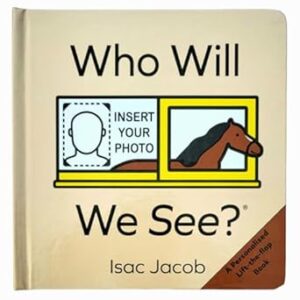Write On! interviews author Isac Jacob
 Isac Jacob, a graduate of King’s College London, is a London-based author and ‘book maker’ known for his innovative early speaking skills storybook, Who Will We See?. Born and educated in Westminster, Isac combines writing, illustrations and papercraft to create engaging, interactive books for young children. Inspired by his own journey of helping his prematurely born twins develop speech during the pandemic, his work is designed to foster early communication skills and emotional learning. While he hasn’t received any awards yet, his unique approach to storytelling continues to gain recognition in the world of children’s education.
Isac Jacob, a graduate of King’s College London, is a London-based author and ‘book maker’ known for his innovative early speaking skills storybook, Who Will We See?. Born and educated in Westminster, Isac combines writing, illustrations and papercraft to create engaging, interactive books for young children. Inspired by his own journey of helping his prematurely born twins develop speech during the pandemic, his work is designed to foster early communication skills and emotional learning. While he hasn’t received any awards yet, his unique approach to storytelling continues to gain recognition in the world of children’s education.
WO: How would you describe your writing to someone new to it?
IJ: My writing is tailored for young children, from as early as nine months to five years old, and focuses on building early speaking skills through playful, engaging and interactive storytelling. It combines repetition with lift-the-flap elements to create an immersive experience that encourages children to recognise and say their own names and those of loved ones. By using people’s photos, my work offers a unique blend of storytelling and real-life connections, allowing children to build confidence, language skills and emotional bonds with family members while nurturing a love for printed books over screens.
WO: Tell us a bit about your latest book, Who Will We See?.
IJ: Who Will We See? is a personalised lift-the-flap storybook that helps children learn to recognise and say their own name, as well as “Mum,” “Dad,” and other people’s names by using passport-sized photos as story characters. Inspired by classic storytelling techniques, similar to those used by Rod Campbell in Dear Zoo, this book stands out by incorporating familiar faces into the narrative, making it both educational and emotionally engaging. Each page invites children to lift the flap and reveal a loved one’s photo, prompting them to say the names aloud. The book can be purchased with pre-installed photos or personalised using the fold-out stencil, allowing families to insert their own pictures. It’s designed to be a fun and revolutionary tool for encouraging early communication, making it an ideal keepsake for families and an engaging way to foster speech development and social skills.
WO: What inspired you to write in the first place, and what inspires you now?
IJ: My initial inspiration came from necessity, the ‘mother’ of all inventions. As I tried to encourage my twins to speak and say their own names, I remembered a personalised birthday card featured on a beloved CBBC program from the nineties. This memory sparked the idea to create a lift-the-flap book using family photos as story characters. When I first read the book to my twins, they were remarkably engaged, especially when I revealed the photos and announced each name. The very next day, they began saying their first words: their own names and those of all seven family members included in the story. This experience inspired me to refine the book further, drawing from ‘The Great Books’ tradition and following in the footsteps of authors like Eric Hill and Rod Campbell.
Today, my inspiration comes from a desire to support other parents and guardians in helping children develop their early speaking skills, an area often overlooked in early childhood education. I’ve learned that early intervention is key to child development, and I’m motivated by the potential impact my book can have. I’m committed to making it accessible and effective, which is why its price starts from £4.99 for the educational version. If Who Will We See? proves enjoyable and helps children, this evidence will continue to inspire me to create more resources, making a positive difference in early education.
WO: A previous issue of Write On! explored the theme of ‘Change’. Do you actively embrace change and the chaos it can bring, especially in your writing routine, or does the idea of any change at all fill you with dread? What tactics can you recommend for coping with change?
IJ: I try to actively embrace change and the chaos it can bring, seeing it as an opportunity for growth and learning. As the joke goes: “Why did the philosopher refuse to give change? Because he believed change comes from within.” I believe embracing change is a path to personal development. In my writing routine, I view change as character-building; when things shift negatively, it fosters patience, and when change is positive, it cultivates gratitude.
To cope with change, I rely on my faith, which serves as my anchor. Having a consistent routine of praying to God in both good times and bad brings me a sense of constancy. I also draw inspiration from others, by reading books and learning from other people who’ve navigated similar changes. The idea of chaos, however, does sometimes conjure up darker imagery, akin to the scenes in Harry Potter. Despite this, I believe change to be transformative and, as a writer, I’m literally following my dreams. My advice is to view change as an opportunity to learn and grow.
WO: What one piece of advice would you give an aspiring writer?
IJ: Just write! Writing is one of the most powerful ways to express yourself and it can be incredibly therapeutic. If your writing has the potential to benefit others or yourself, then you have a moral obligation to share it. Also, here’s a piece of wisdom I once received from a wise banker: “Whatever you do professionally, do it beautifully.” Approach your craft with care, dedication and a commitment to excellence, and the beauty in your work will always shine through.
WO: Question from Instagram user: @madeleinefwhite – What are the specific challenges in writing books aimed at young children?
IJ: Writing books for young children comes with several challenges. The UK boasts a world-class literacy standard, so any book must not only meet these high expectations but also teach something new and valuable. Engaging young readers is increasingly difficult, particularly with the pervasive influence of screens and tablets competing for their attention. Additionally, the book must be easy for parents to incorporate into busy routines, ensuring it’s affordable and appealing. At Who Will We See?, we’ve addressed these challenges by creating a DIY personalised lift-the-flap storybook that uses family photos as characters. This approach fosters engagement, encourages early speech development and makes reading a fun and meaningful experience for both children and their families.
WO: Can you tell us anything about future projects?
IJ: As an independent publisher, author, illustrator and paper architect, I have a deep understanding of book design and am excited about future projects that will instil a love of books in children from an early age. I’m currently working on additional personalised lift-the-flap storybooks to accommodate larger classes in primary schools. This project is still in its early stages, allowing for flexibility in its design. I welcome collaboration and input on how to make this book even more beneficial for educational settings, particularly in terms of supporting early development and getting children enjoying printed books again. If you have ideas or would like to contribute, please feel free to reach out!
WO: Lastly, if you could choose one fictional animal/creature to be a pet or companion, who would it be and why?
IJ: It would definitely be Spirit, the horse, from Kathleen Duey’s wonderful book. He embodies the values of staying true to oneself and living in harmony with nature. I admire how he bravely channels his energy and efforts towards his needs and aspirations, ultimately succeeding in his journey. Having a companion like Spirit would inspire me to embrace authenticity, resilience, and a deep connection with the world around me. Plus, there’s something incredibly freeing about the idea being alongside such a majestic creature!
the values of staying true to oneself and living in harmony with nature. I admire how he bravely channels his energy and efforts towards his needs and aspirations, ultimately succeeding in his journey. Having a companion like Spirit would inspire me to embrace authenticity, resilience, and a deep connection with the world around me. Plus, there’s something incredibly freeing about the idea being alongside such a majestic creature!
You can find out more about Isac Jacob on LinkedIn: www.linkedin.com/in/isac-jacob. Who Will We See? is available to buy from www.tiktok.com/@who_will_we_see
*****
Issue 22 is out now. You will find it in libraries and other outlets. Alternatively all current and previous editions can be found on our magazines page here.

You can hear great new ideas, creative work and writing tips on Write On! Audio. Find us on all major podcast platforms, including Apple and Google Podcasts and Spotify. Type Pen to Print into your browser and look for our logo, or find us on Podcasters.Spotify.com.
*****
If you or someone you know has been affected by issues covered in our pages, please see the relevant link below for information, advice and support: https://pentoprint.org/about/advice-support/



